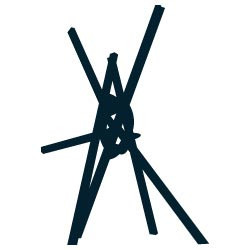Mark di Suvero For Older Children

Clock Knot
Mark di Suvero
Subject: Balance
Activity: Creating a sculpture that balances
Materials: Acrylic paint (optional), chopsticks, pencils, or Popsicle sticks; adhesive tape, glue, string, or twist ties
Vocabulary: Angle, balance, crane, lift, vertical
Mark di Suvero often uses large steel beams to create his sculptures. His sculptures are so large that he has to use a crane to lift the beams and set them in place. Di Suvero works in New York City and is influenced by the construction of massive skyscrapers. In his works, he is interested in balance and lift. Clock Knot balances well on four beams, despite its precarious angles. It is called Clock Knot because it looks a little like a giant clock face with a clock hand that extends from the center.
Do you think the sculpture looks balanced? How difficult do you think it was for di Suvero to achieve balance?
Walk around the sculpture. How does the sculpture change? Walk under the sculpture. What is it like looking up from underneath the sculpture?
Do you think this sculpture looks like a clock? Why or why not?
Collect a variety of objects such as chopsticks, pencils, or Popsicle sticks. Try to balance the objects together using adhesive tape, glue, string, or twist ties. When you are done, paint your sculpture with acrylic paint if you like.
Angle - two lines that extend from the same point
Balance - to keep steady
Crane - a machine for raising, shifting, and lowering heavy weights
Lift - lifting up or elevating; an elevation of the spirit
Vertical - positioned upright, like a flagpole, and opposite of horizontal
